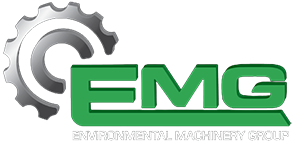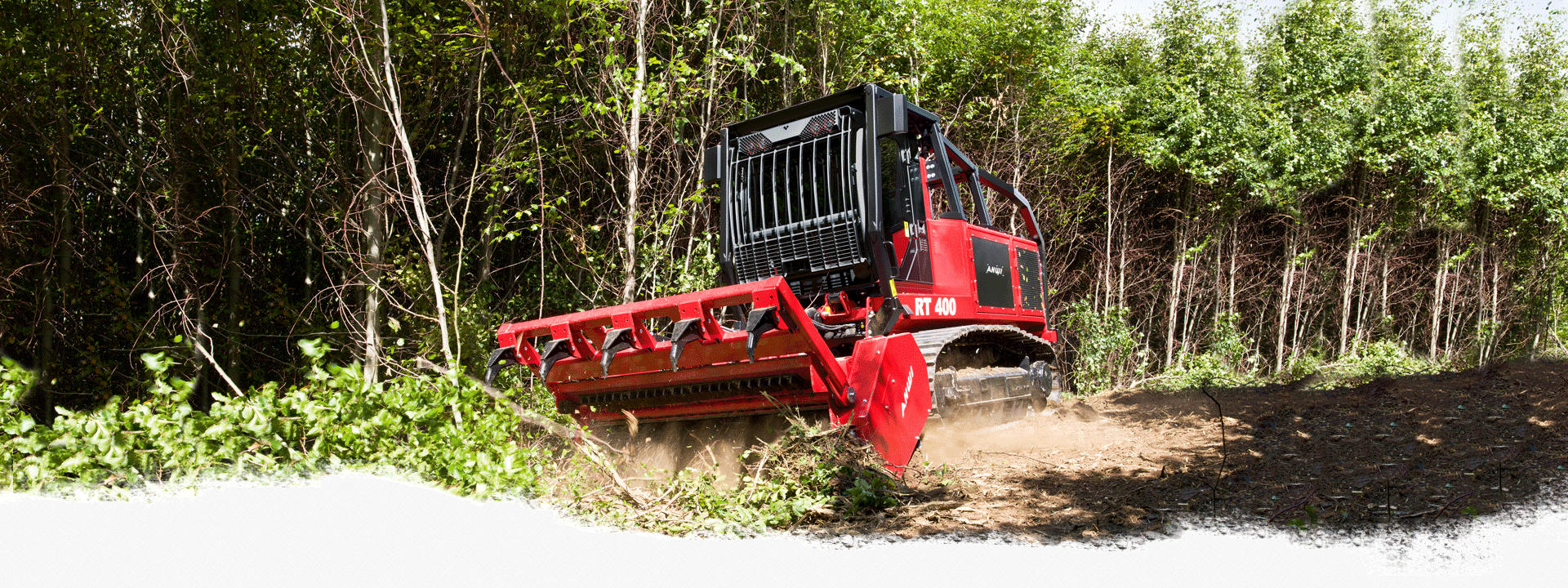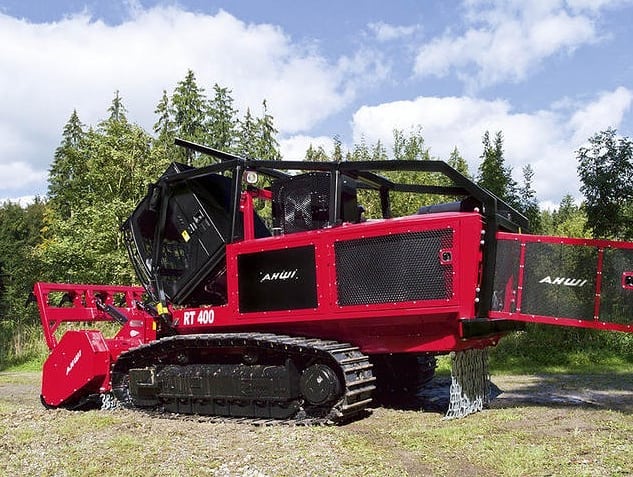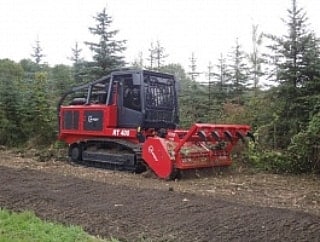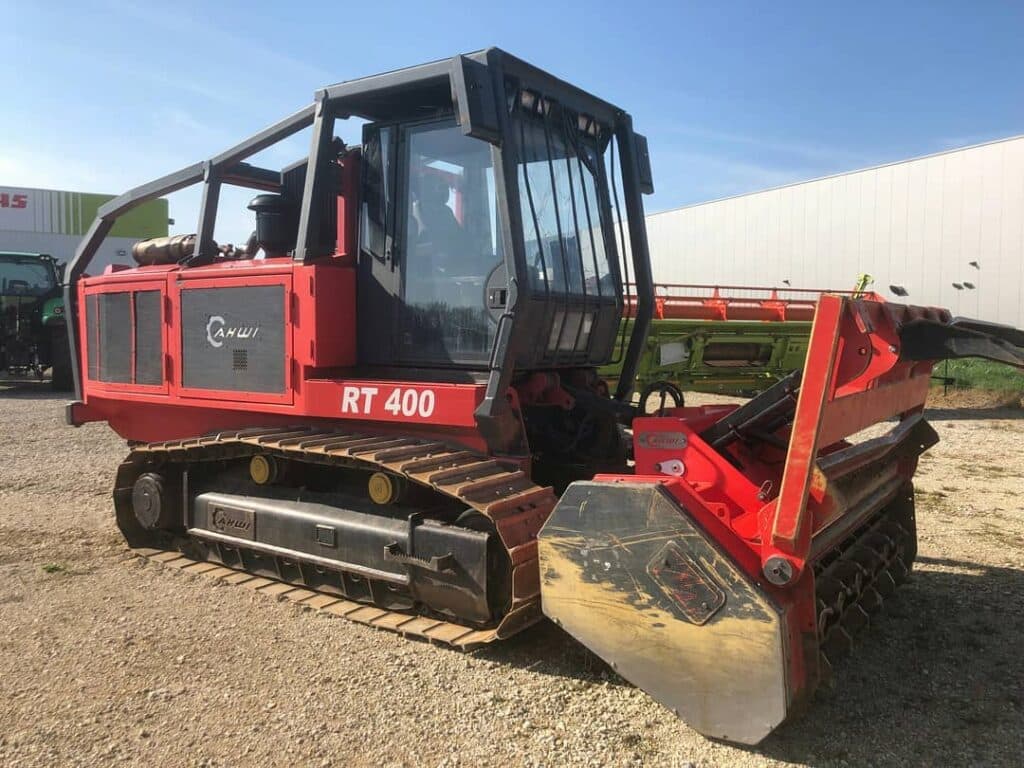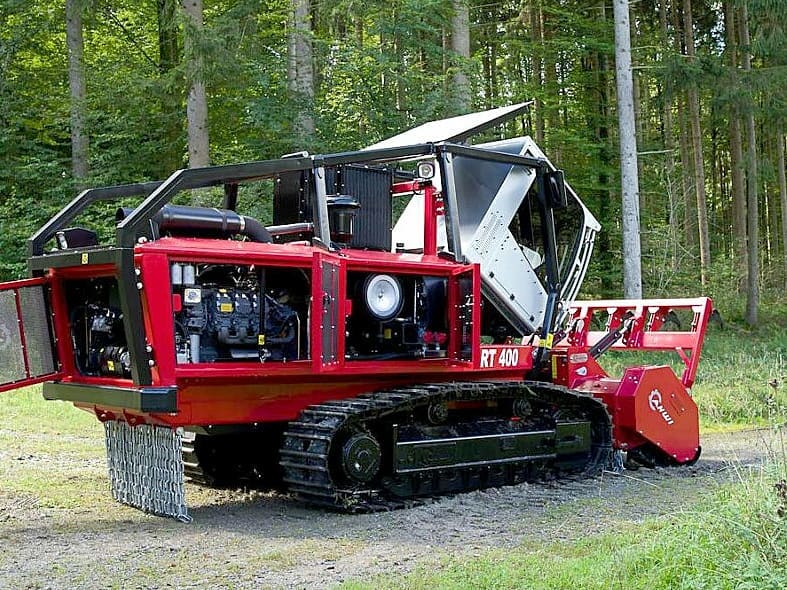RT 400
The carrier for heavy accessory and clearing equipment
As a powerful carrier for heavy accessory equipment with a power take-off shaft, the RT 400 is designed for heavy forestry operations. We sell the RT 400 with the UZM700, the RF1000 or H600 as standard. The high efficiency of the mechanical drive train and the low centre of gravity guarantee maximum productivity in any terrain.
Technical Data
| Power | 294 kW / 400 HP |
| Engine | Deuz TCD 2015 |
| Maximum speed [km/h] | 5.5 |
| Weight [kg] with mulcher (without mulcher) | 20270 (16000) |
| Drive dimension | D5H |
| Width of the standard base plate [mm] | 600 |
| Ground pressure [g/cm²] | 480 |
| Gradeability frontal/sideways [degree] | 45°/30° |
| Vehicle dimensions incl. mulcher (length x width x height) in mm | 4825 x 3240 x 2750 |
| Note | Technical changes made during the course of further development are reserved. |
Your advantages at a glance

Traction
Excellent traction and off-road mobility thanks to a perfect centre of gravity

Efficiency
Maximum efficiency due to the mechanical drive and maximum load control
Application Areas
Extraction and access routes
Access routes are created to transport harvested timber from the forest to the respective loading areas. These tracks are usually unpaved roads which are maintained or kept available for long periods for accessing forest stands.
A conventional strategy here is to manually create these paths. However, the problems with this method include the removal of timber and the issue of stumps. Mulching “disintegrates” these two problems. The chopped biomass is scattered on the ground and gives the forest soil precious added nutrients. In addition, stumps are processed and do not restrict future use of the land.
Wildfire & prevention
Surface vegetation acts as a fuel source and greatly increases the risk of fire and the speed of spread.
Our equipment can break up any type of vegetation whether trees or understory reducing the fuel load in such a way that it is possible to limit the damage caused by forest fires with a procedure that is minimally invasive to the environment.
Land clearing
The phrase “land clearing” involves a range of different applications and terms. In many cases, site clearance refers to secondary vegetation and for construction clearance. This may involve forest clearance for areas intended for use such as wind farms, parks, road construction or golf courses.
It may also include applications such as the removal of windblown timber or burnt areas, preparation work for surface mining and of equal importance, amenity areas. Site clearance can also be considered in plantations, arboretums, horticulture and landscaping.
When clearing large areas, no selective mulching takes place, as large areas or parcels with a range of different types of vegetation are processed by the mulcher. In many areas of the world, other methods are used for the same purpose, such as slash and burn, chaining or simply bulldozing the area. When these methods are used, vegetation is uprooted by bulldozers or stretched chains, and then burned or buried. In contrast to these methods, mulching is the process with the lowest degree of intervention in the ecosystem. Whether mulchers or rotorvator are used, the shredded biomass remains and greatly improves the fertility of the soil.
Plantation agriculture
The plantation industry involves a variety of applications. These range from forestry plantations with eucalyptus, pines and similar, to Christmas tree stands and short rotation plantations, oil palm plantations and fruit plantations such as pineapple, bananas, apples, etc.
The use of mulch technology in plantation agriculture may involve mulching all of the vegetation or just the harvest remains and root stocks. Among other things, this involves plant preparation for the next crop.
The soil is also often processed with a rotovator after mulching to also remove the tree stumps and roots in the ground. Cultivated and fertile soil performs better for new seed planting. Root stocks and harvest residues are often extremely obstructive when using machines for maintenance and harvesting. A particular feature in this area is that there are no significant alternatives to our technology for an environmentally and economically sustainable plantation industry.
Infrastructure measures
Infrastructure measures are any measures that are used to build and maintain infrastructures. Among other things, those include complete or selective clearing or land management in preparation for infrastructure construction work.
Furthermore, it also includes infrastructure maintenance and clearing around existing installations. That includes street and road construction and the expansion of rail networks or airports.
Removal of beetle-infested wood
In general, the problem starts with a few “weak” trees that are infested by pests. Over time, the infestation spreads and the damage grows. For this reason, selected trees should be removed from the forest as quickly as possible.
After felling and transporting them to the collection point, the trees are stripped and the bark is discarded or burned. Nowadays, this process is still carried out by hand in many places. Mulching is an attractive alternative, which averts the risk of the infestation spreading quickly.
Reclamation
Re-cultivation is the exploitation of land for economic purposes, such as plantations or agriculture. Soil preparation is a common feature of this process.
In many cases, re-cultivation is closely related with the clearance of large areas or forest clearance and also the shredding of stumps and root material. This can either involve secondary vegetation or trees. A mulcher is used to process vegetation on the surface. A rotovator is then used to deal with any remaining vegetation or stumps which are still in the ground, which are then combined with the mulched material and mixed into the soil.
Special applications
Such as Seismic lines, Natural availability, Landscape maintenance, Habitat maintenance, Embankment maintenance, Re-naturalization, Composting.
Right-of-way maintenance
Line maintenance involves keeping electricity and overhead cables, underground cables, pipelines and railway lines clear. The areas which need to be kept clear are often difficult to access.
Options may be limited due to steep slopes, soft ground or rough terrain, so the areas are often cleared manually. Our products, whether tracked utility vehicles or mulchers, offer an economical alternative in such situations. Particularly in challenging terrain where our tracked utility vehicles can be the first choice.
Stump grinding
This often refers to stump milling, tree stump shredding or root stock recycling. This may involve rootstock processing with a stump grinder on site and leaving the ground material behind.
A second option is to process the stumps in the ground with a rotovator. Another method is to mulch or shred tree stumps or root balls on the surface that have been excavated in a previous process e.g., Using excavators, bulldozers or track loaders.
